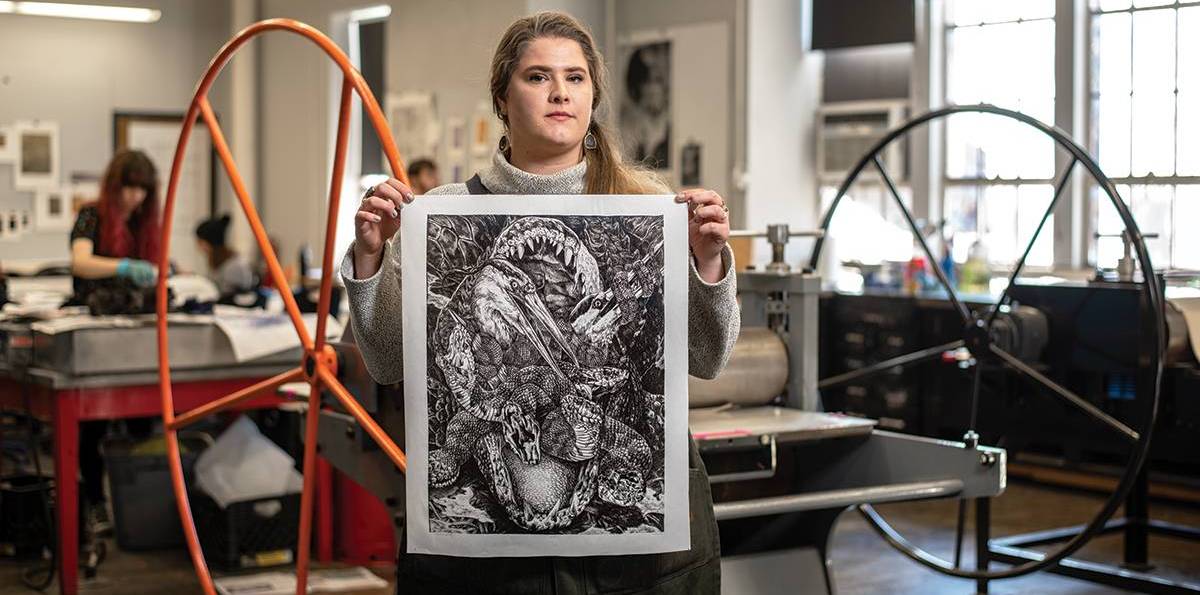Drawing in the negative: Printmaker reclaims empowerment through art
By Stephanie Jacques

Pain, betrayal and visceral emotion cascade from the giant sheets of paper that graduate student Hailey Quick uses to process her feelings about a family trauma. In more ways than one, her powerful images start with the negative.
“My art deals a lot with trauma, the pain behind it and processing those memories,” said Quick, master’s student in printmaking in the Kansas State University College of Arts and Sciences. “As I create a piece, I reflect on how I was feeling at the time and now.”
Quick’s Renaissance-like artwork reflects her childhood and love of Louisiana wildlife. She assigns animals to represent different people and incorporates them in dramatic and detailed scenes. She heals by creating large 16-by-20-inch prints of an alligator surrounded by wasps, a great blue heron intertwined with a wood stork, or intermingled herons and snakes inside an alligator’s mouth.
“I fell in love with the intensity of the printmaking processes as well as the heavy drawing,” Quick said. “Seeing the finished prints fresh off the press is just so special because it takes so much to get it on paper compared to the immediate gratification of just a pencil and paper.”
Printmaking is an extensive process and it takes days for Quick to create a piece. She starts in her studio surrounded by black and white images of her past creations. Using a soft ground technique and lithographic crayon made of grease, she draws on a copper plate in the negative, or the reverse of how she wants the finished piece.
The grease acts as a barrier between the plate and the acid; it slowly breaks apart in an acid bath and etches what is exposed. The thicker Quick applies the grease, the longer it takes to fall off when the copper plate is placed in a corrosive acid bath. The combination of time in the bath and thickness of the grease determines the shade and line thickness in the finished print.
“The acid creates channels in the copper plate,” Quick said “The longer the plate is in the acid, the deeper and wider the channel, which will hold more ink. Less time will create a shallower and narrower channel so it will hold less ink.”
Quick repeats the process to get the desired channel size. When a plate is finished, Quick applies the ink, which settles in the channels, and she wipes away the excess. She places paper on top and presses the two pieces together.
“Printmaking is where I can present my academic work, which is different than the aesthetic art that most people would see in a store,” Quick said. “Instead of a happy bird, I like to draw my birds tearing each other apart. It’s more emotional than aesthetic.”
In spring 2021, Quick will present her research work as a conference demonstration at the University of Colorado Boulder. The Embracing the Wilds conference is part of the Colorado Month of Printmaking, or Mo’Print.
“Hailey is a very talented and driven artist with important work,” said Jason Scuilla, professor of art and Quick’s adviser. “She fearlessly confronts her past experiences with beautiful hand-rendered images of struggle and perseverance. Hailey has excelled in her graduate studies and is an inspiration to our undergraduate students in the art Department.”
According to Quick, her art and the printmaking community have helped her cope with repressed feelings and everyday life. She is not ready to talk publicly about what has happened to her, but hopes her art conveys the emotions.
“It’s OK that my audience doesn’t know exactly what’s going on, but they can still get the feelings that are happening — the raw emotion and my quest to reclaim my sense of empowerment after trauma,” Quick said.
